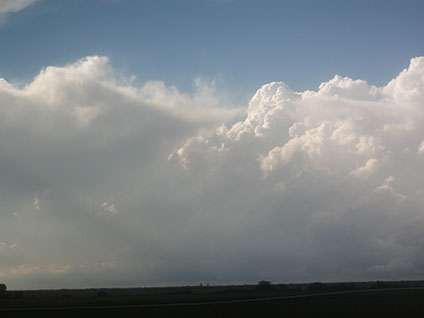Atmospheric ice particles smaller and fall faster than models had assumed

Depending on their height and thickness, ice clouds could either warm or cool Earth's surface. Getting the details of these clouds right in global climate model (GCM) simulations is an important step toward increasing the accuracy of future climate projections. Researchers showed that ice particles detrained from deep convective clouds (such as thunderstorms) are smaller and fall faster than previously assumed. Their study relied on aircraft observations from multiple field campaigns. Scientists used this new knowledge to better represent ice clouds in a GCM. This information also helps improve GCM simulation of ice clouds in and near regions of active convection and heavy rain.
The National Aeronautics and Space Administration (NASA) Global Institute for Space Studies GCM previously produced too much cloud ice. The overabundance of ice was especially prominent in regions near the equator and in the midlatitudes where deep, raining clouds are often found. Using the new ice cloud formulation, model simulations reduce the amount of ice by 30 to 50 percent. The research brings the model results into better agreement with global satellite observations. The new model provides more accurate simulations of the life cycle of these deep convective storm systems, which play important roles in Earth's energy and water cycles.
Recent studies showed that the NASA Global Institute for Space Studies GCM produced upper tropospheric ice water contents that exceeded an estimated upper bound by a factor of two. Scientists traced this issue to the approach used in the GCM for partitioning ice formed in deep convective updrafts into falling (i.e., snow) and lofted/detrained (i.e., cloud) components. They analyzed aircraft observations of ice clouds adjacent to deep convective cloud cores to develop new observational benchmarks for ice particle sizes and fall speeds. Observations used in the study include data from the Atmospheric Radiation Measurement (ARM) – NASA Midlatitude Continental Convective Clouds Experiment (MC3E) and the ARM Small Particles in Cirrus (SPARTICUS) campaigns. The U.S. Department of Energy's ARM Climate Research Facility and NASA sponsored the campaigns.
Based on the aircraft observations, researchers determined that the convective ice particles as represented in the model were often too large and fell too slowly. To correct this issue, the researchers developed new empirical relationships for the sizes and fall speeds of ice particles near active convection and implemented those relationships into the GCM convective parameterization. Because ice particles in deep clouds are smaller, but fall faster, there is an overall decrease in cloud ice water content in deep convective regions. The new cloud ice simulation agrees better with global satellite retrievals. The study highlights the value of using multiple field campaign and satellite observations in both the GCM development step and subsequent GCM evaluation step.
More information: Gregory S. Elsaesser et al. An Improved Convective Ice Parameterization for the NASA GISS Global Climate Model and Impacts on Cloud Ice Simulation, Journal of Climate (2017). DOI: 10.1175/JCLI-D-16-0346.1
Journal information: Journal of Climate
Provided by US Department of Energy




















